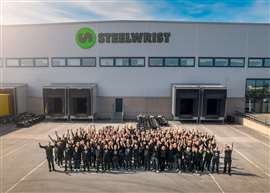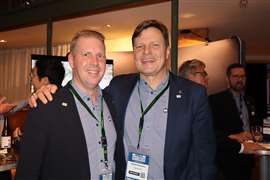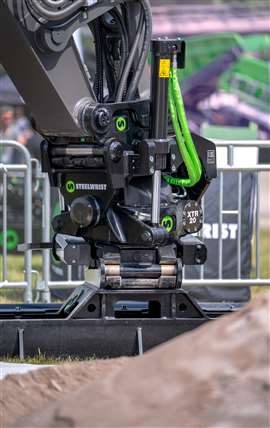Building Effective Communication: Insights from Steelwrist’s Stefan Stockhaus
07 November 2024
 Steelwrist staff in Rosersberg, Sweden (Photo: Steelwrist)
Steelwrist staff in Rosersberg, Sweden (Photo: Steelwrist)
While speaking to other managers and leaders in the demolition and recycling industry is a vital way to gain knowledge in how to overcome these challenges, looking to large scale industries, such as construction OEMs, also provides key learning opportunities and new perspectives that can help contractors operate their businesses.
This is where Stefan Stockhaus, CEO of global quick coupler and tiltrotator manufacturer Steelwrist, offers a compelling example of how a communication-driven culture can transform an organisation.
By establishing clear values, direct communication, and accountability, Steelwrist has crafted a cohesive and resilient team culture that drives both internal harmony and competitive success.
Stefan’s insights into building a high-trust workplace, one where openness and shared goals eliminate the guesswork, provide a practical model that any contractor seeking sustainable growth can appreciate—and apply.
Inside Steelwrist: How to build a communication-driven culture
At Steelwrist, communication isn’t just a goal—it’s an intrinsic part of the company’s culture. Stefan Stockhaus, CEO of the global attachment manufacturer, has crafted an environment of open dialogue, trust, and responsiveness, where communication guides every layer of the business. His approach offers a look at how Steelwrist’s cohesive and transparent culture fuels the organisation’s success and inspires lessons for leaders in any industry.
Creating Alignment and Clarity
Creating alignment and clarity among employees is one of Stefan’s top priorities. “The idea is that everyone in the organisation has a shared understanding of where we’re going and, more importantly, why we’re heading there,” he explains. This principle of transparency isn’t just about goals; it also permeates hiring. Stefan interviews every new hire—not to vet their technical skills but to “see if they fit the culture,” ensuring a team of individuals who share Steelwrist’s vision. “I give them a specific introduction to what we’re about,” he says, describing his presentation on Steelwrist’s values.
 Karl Serneberg and Stefan Stockhaus at the World Demolition Summit in Stockholm, Sweden (Photo: KHL Group)
Karl Serneberg and Stefan Stockhaus at the World Demolition Summit in Stockholm, Sweden (Photo: KHL Group)
Defining Core Values with the “HOT” Principle
For Stefan, every employee must not only understand the company’s vision but also have a shared definition of core terms—a concept he refers to as the “Communication Rule.” The rule comprises three principles: Be HOT (honest, open, and transparent), Don’t Guess, and Remember There Is Always Another Perspective. These principles serve as Steelwrist’s guideposts for building a culture of openness. “Assumption is the mother of all f**k-ups,” he asserts, emphasising the importance of direct communication. For Stefan, being “HOT” means speaking candidly and sincerely about both successes and challenges, eliminating guesswork from daily interactions.
The HOT principle also underpins Steelwrist’s approach to resolving misunderstandings. Stefan believes honesty builds the foundation of trust necessary for any organisation to thrive. Employees are encouraged to express issues openly, rather than masking or downplaying concerns. Being “open” goes hand-in-hand with transparency, ensuring information flows freely across the team. In Stefan’s words, “If people have to guess what others mean, it leads to miscommunication.” By making honesty, openness, and transparency core expectations, Steelwrist fosters an atmosphere where questions and feedback are not only welcomed but actively encouraged.
Building Inclusivity and Embracing Diverse Perspectives
Steelwrist’s approach to teamwork extends beyond projects and into the realm of cultural inclusivity. With multicultural teams in countries like Japan, the US, and Norway, Stefan recognises that different perspectives add value and complexity. “If you want people to understand the company’s values, you need to invest time explaining them,” he notes. This inclusive approach involves not only clarifying Steelwrist’s core values but also valuing the insights that each culture brings. For Stefan, it’s essential to bridge any gaps between these perspectives to build unity and collaboration across his global teams.
Accountability and Real-Time Communication
Accountability is another foundational element of Steelwrist’s communication culture. Stefan discourages email as a way to safeguard against mistakes; instead, he advocates for real-time, direct conversations. “Talk to each other,” he advises, explaining that face-to-face interactions can prevent misunderstandings that often arise in written communication. Stefan also insists that employees bring multiple solutions to any problem they present. “If there’s only one idea on the table, it’s often a debate about who’s right. But if there are two, the conversation shifts to what’s best.” This shift from a right-or-wrong perspective to one of collaborative problem-solving builds trust and encourages employees to engage actively.
Empowering Decision-Making with a Growth Mindset
Decision-making at Steelwrist is designed to be efficient and growth-oriented. Employees are encouraged to make choices confidently, even if they risk making mistakes, and Stefan is vocal about prioritising “making new mistakes” over repeating old ones. “If people are afraid of taking risks because
 Stefan’s leadership is shaped by a commitment to clear and direct communication (Photo: Steelwrist)
Stefan’s leadership is shaped by a commitment to clear and direct communication (Photo: Steelwrist)
of the consequences, everything slows down,” he says, adding that Steelwrist’s culture embraces mistakes as long as they serve as learning opportunities. This approach to learning enables the team to maintain momentum and keeps the company agile, especially in an industry that demands adaptability.
Collective Responsibility Through “Coworkership”
A sense of collective ownership—what Stefan calls “coworkership”—also forms a critical part of Steelwrist’s culture. At Steelwrist, “coworkership” means every employee takes responsibility not only for their individual role but also for contributing to the organisation’s overall success. “It’s important for every individual to feel responsible not just for their job but for contributing to the organisation as a whole,” Stefan explains. He describes how Steelwrist’s low tolerance for “snowballing” problems—allowing minor issues to grow into bigger problems—keeps everyone on the same page. Employees are encouraged to address issues early, helping maintain Steelwrist’s proactive and unified culture.
Leading with Clear and Direct Communication
Stefan’s leadership is shaped by a commitment to clear and direct communication. His military background in the Swedish Navy taught him the value of responsibility and straight talk—traits he continues to practice at Steelwrist.
Averse to vague pronouns, Stefan is specific in his language, ensuring that everyone knows exactly who is responsible for what. “If I say: ‘he should have done that,’ there’s no clarity. It’s much better to say: ‘John should have completed that task on Thursday.’” For Stefan, leading by example in clarity and transparency allows his team to communicate more effectively and openly.
The Influence of NLP: “My Map is Not Your Map”
Stefan’s early training in neurolinguistic programming (NLP) influenced his communication philosophy, teaching him to recognise that “my map is not your map.”
This awareness of individual perspectives helps Stefan avoid assumptions and misunderstandings, encouraging team members to clarify rather than presume understanding.
“If people have to guess what others mean, it leads to miscommunication,” he remarks, adding that the training helped him appreciate how varied people’s interpretations can be.
A Practical Model for Communication-Driven Leadership
Leaders, according to Stefan, should prioritise explaining the “why” behind decisions, which empowers employees to make aligned choices without needing constant direction.
He advises against relying heavily on email for complex conversations, as face-to-face interactions allow for clearer communication. He also champions decisive action, cautioning against the pitfalls of slow decision-making, which can lead to stalled progress and lost opportunities.
At Steelwrist, the communication culture is not about enforcing rigid rules but is centred around creating an environment where people feel secure enough to speak up, collaborate, and learn from one another.
“You can’t expect others to follow if you don’t hold yourself to the same standards,” Stefan insists, noting that leaders must embody the traits they wish to see in their teams. While Stefan admits there have been times when this has led him to take on too much, his approach offers a straightforward and practical model for fostering a high-trust, responsive workplace culture—a strategy that serves Steelwrist well as it navigates the demands of an evolving industry.
STAY CONNECTED



Receive the information you need when you need it through our world-leading magazines, newsletters and daily briefings.
CONNECT WITH THE TEAM






